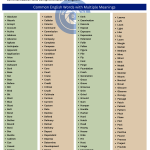What are Punctuation Marks?
Punctuation marks are symbols used in writing to clarify meaning and indicate pauses or breaks in a sentence. They are essential for conveying tone, structure, and organization in written communication. Punctuation marks can change the meaning of a sentence or clarify the writer’s intent.
Some common punctuation marks include the period, question mark, exclamation point, comma, semicolon, colon, dash, parentheses, quotation marks, and ellipsis. Each of these marks has its own unique purpose and usage.
For example, the period is used to end a sentence, the comma is used to separate items in a list or to separate clauses within a sentence, and the quotation marks are used to indicate direct speech or a quotation.
Using proper punctuation is important for clear and effective communication. It can help to eliminate ambiguity and confusion in written communication, making it easier for the reader to understand the message.
Download Words Coach Application
Punctuation Marks
Here are some common punctuation marks with their names, definitions, usage, and examples:
- Period (.) – used to end a sentence.
Example: She is going to the store.
Rule: Use a period to end a sentence. - Question Mark (?) – used to end a direct question.
Example: What time is it?
Rule: Use a question mark at the end of a direct question. - Exclamation Point (!) – used to express strong emotion or emphasis.
Example: Congratulations!
Rule: Use an exclamation point to express strong emotion or emphasis. - Comma (,) – used to separate items in a list, or to separate clauses or phrases within a sentence.
Example: She likes pizza, pasta, and salad.
Rule: Use a comma to separate items in a list, or to separate clauses or phrases within a sentence. - Semicolon (;) – used to connect two independent clauses that are closely related.
Example: She was tired; however, she continued working.
Rule: Use a semicolon to connect two independent clauses that are closely related. - Colon (:) – used to introduce a list, or to introduce an explanation or example.
Example: There are three things to remember: honesty, loyalty, and respect.
Rule: Use a colon to introduce a list, or to introduce an explanation or example. - Dash (-) – used to indicate a pause or to emphasize a phrase.
Example: She was the winner of the race – the first one to cross the finish line.
Rule: Use a dash to indicate a pause or to emphasize a phrase. - Parentheses () – used to enclose additional information or an aside within a sentence.
Example: The party (which was held at her house) was a success.
Rule: Use parentheses to enclose additional information or an aside within a sentence. - Quotation Marks (“) – used to indicate direct speech or a quotation.
Example: “I love ice cream,” she said.
Rule: Use quotation marks to indicate direct speech or a quotation. - Ellipsis (…) – used to indicate a pause or omission of words within a sentence.
Example: “To be or not to be…”
Rule: Use an ellipsis to indicate a pause or omission of words within a sentence.
It is important to use punctuation correctly in order to convey meaning effectively and avoid confusion. Additionally, the rules for punctuation can vary depending on the style guide being used, so it is important to consult a trusted resource when in doubt.







